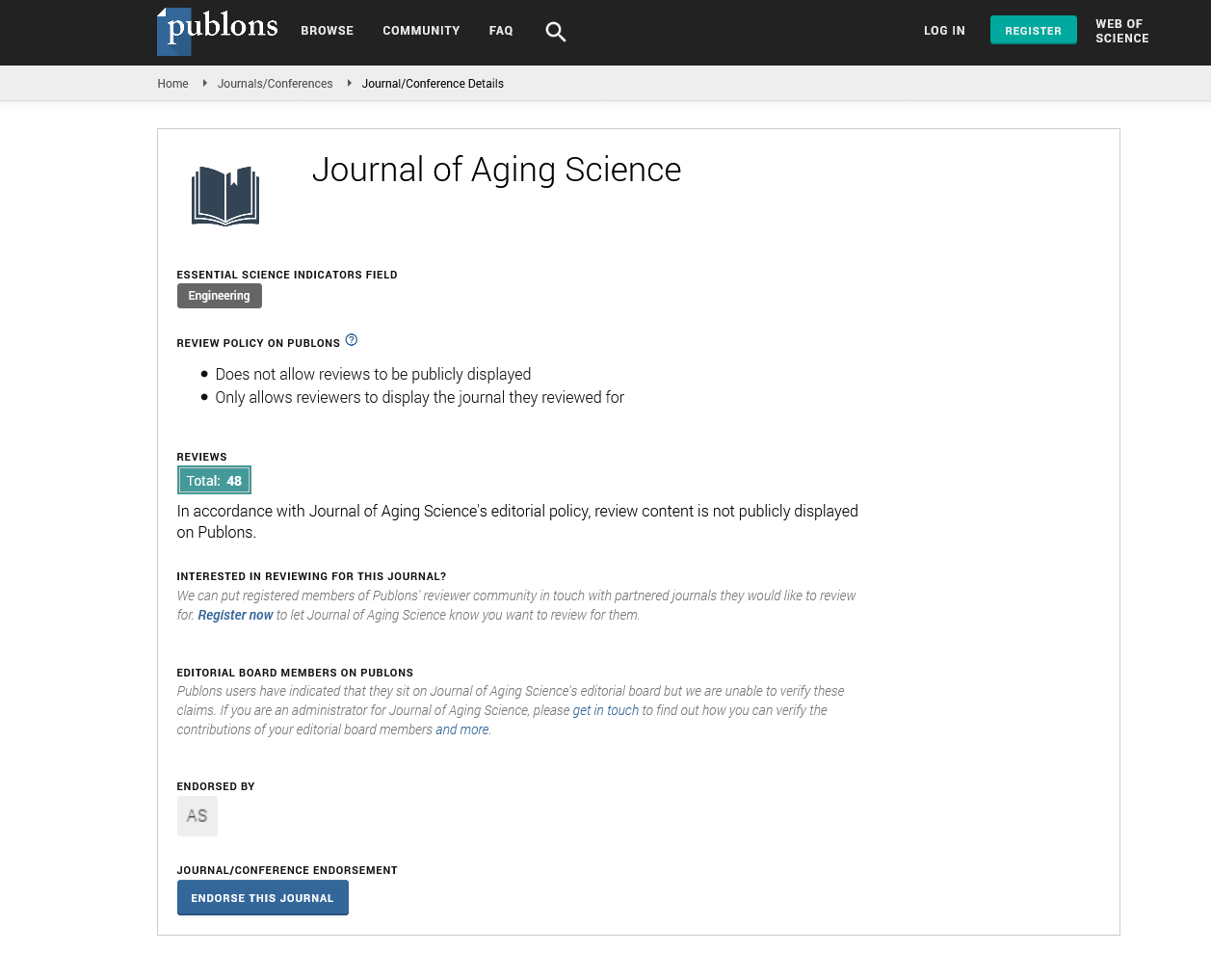Indexed In
- Open J Gate
- Academic Keys
- JournalTOCs
- ResearchBible
- RefSeek
- Hamdard University
- EBSCO A-Z
- OCLC- WorldCat
- Publons
- Geneva Foundation for Medical Education and Research
- Euro Pub
- Google Scholar
Useful Links
Share This Page
Journal Flyer

Open Access Journals
- Agri and Aquaculture
- Biochemistry
- Bioinformatics & Systems Biology
- Business & Management
- Chemistry
- Clinical Sciences
- Engineering
- Food & Nutrition
- General Science
- Genetics & Molecular Biology
- Immunology & Microbiology
- Medical Sciences
- Neuroscience & Psychology
- Nursing & Health Care
- Pharmaceutical Sciences
Commentary - (2025) Volume 13, Issue 2
Sleep Disturbances as a Predictor of Cognitive Decline in Aging
Robert Reis*Received: 28-Mar-2025, Manuscript No. JASC-25-28627; Editor assigned: 31-Mar-2025, Pre QC No. JASC-25-28627 (PQ); Reviewed: 07-Apr-2025, QC No. JASC-25-28627; Revised: 14-Apr-2025, Manuscript No. JASC-25-28627 (R); Published: 28-Apr-2025, DOI: 10.35248/2329-8847.25.13.411
Description
Aging is a natural process associated with various physiological and neurological changes, including alterations in sleep patterns. Sleep disturbances are increasingly recognized as a significant risk factor for cognitive decline and neurodegenerative diseases such as Alzheimer’s Disease (AD) and other forms of dementia. While occasional sleep disruptions are common, chronic sleep disturbances, including insomnia, sleep apnea and fragmented sleep, can have extreme effects on brain health. Understanding the relationship between sleep and cognitive decline is necessary for early intervention and prevention strategies in aging populations.
Sleep and brain health
Sleep is a complex physiological process important for cognitive function, memory consolidation and brain plasticity. It consists of different stages, including Rapid Eye Movement (REM) sleep and Non-Rapid Eye Movement (NREM) sleep. Slow-Wave Sleep (SWS), a stage of deep NREM sleep, is particularly important for memory consolidation and the clearance of neurotoxic waste, such as beta-amyloid proteins, which are implicated in neurodegenerative diseases.
Types of sleep disturbances and their impact on cognition
Several types of sleep disturbances are associated with cognitive decline in older adults. The most commonly studied include insomnia, sleep-disordered breathing (e.g., sleep apnea) and disruptions in circadian rhythms:
Insomnia and cognitive function: Insomnia, characterized by difficulty falling or staying asleep, affects a significant proportion of the aging population. Studies suggest that chronic insomnia is associated with deficits in attention, working memory and executive function. Prolonged sleep deprivation leads to increased oxidative stress and neuroinflammation, both of which are linked to neuronal damage and cognitive decline.
Sleep apnea and neurodegeneration: Obstructive Sleep Apnea (OSA) is a common sleep disorder characterized by repeated episodes of breathing cessation due to upper airway obstruction. OSA leads to intermittent hypoxia, which results in reduced oxygen supply to the brain. This condition has been strongly linked to cognitive impairments, particularly in attention, memory and executive function. Research indicates that untreated OSA increases the risk of developing Mild Cognitive Impairment (MCI) and dementia. The mechanisms underlying this relationship include oxidative stress, inflammation and disruption of cerebrovascular function, all of which contribute to neurodegenerative processes.
Circadian rhythm disruptions and cognitive decline: Circadian rhythms regulate sleep-wake cycles and are necessary for maintaining cognitive function. Aging is associated with disruptions in circadian rhythms, often leading to irregular sleep patterns and increased daytime sleepiness. A disrupted circadian system impairs synaptic plasticity, reduces the effectiveness of memory consolidation and may accelerate cognitive decline. Disorders such as Advanced Sleep Phase Syndrome (ASPS) and Irregular Sleep-Wake Rhythm Disorder (ISWRD) are common in older adults and are associated with an increased risk of neurodegenerative diseases.
Mechanisms linking sleep disturbances to cognitive decline
Several biological mechanisms explain how sleep disturbances contribute to cognitive decline in aging.
Impaired glymphatic clearance: The glymphatic system is responsible for clearing metabolic waste products from the brain during sleep. Deep sleep, particularly SWS, enhances the clearance of neurotoxic proteins such as beta-amyloid and tau, which accumulate in Alzheimer’s disease. Sleep disturbances, particularly reduced SWS, impair glymphatic clearance, leading to the accumulation of these toxic proteins and increasing the risk of neurodegeneration.
Neuroinflammation and oxidative stress: Chronic sleep disturbances lead to increased levels of pro-inflammatory cytokines and oxidative stress, both of which contribute to neuronal damage and cognitive decline. Neuroinflammation has been implicated in the progression of Alzheimer’s disease and other dementias, further emphasizing the importance of quality sleep in aging populations.
Disruptions in neurotransmitter function: Sleep is necessary for maintaining neurotransmitter balance, including acetylcholine, dopamine and serotonin, which are important for cognitive processes. Sleep disturbances alter neurotransmitter function, leading to deficits in learning, memory and executive function.
Evidence from longitudinal studies: Several longitudinal studies have established a strong link between sleep disturbances and cognitive decline. Research from the Alzheimer’s Disease Neuroimaging Initiative (ADNI) suggests that poor sleep quality is associated with increased beta-amyloid deposition, an attribute of Alzheimer’s disease. Other studies have found that individuals with chronic insomnia or sleep apnea are at a significantly higher risk of developing mild cognitive impairment or dementia compared to those with normal sleep patterns.
Potential interventions and preventive strategies
Given the strong association between sleep disturbances and cognitive decline, early intervention is important for mitigating risks.
Behavioral and lifestyle modifications: Improving sleep hygiene through behavioral interventions can significantly enhance sleep quality. Strategies include maintaining a consistent sleep schedule, reducing screen exposure before bedtime and avoiding stimulants such as caffeine and alcohol. Cognitive-Behavioral Therapy for Insomnia (CBT-I) has been shown to be highly effective in treating chronic sleep disturbances.
Treatment of sleep apnea: For individuals with OSA, Continuous Positive Airway Pressure (CPAP) therapy is the standard treatment. Studies suggest that CPAP use can improve cognitive function and reduce the risk of developing dementia. Early diagnosis and treatment of OSA are necessary for preserving brain health in older adults.
Melatonin and chronotherapy: Melatonin supplementation and light therapy are potential interventions for circadian rhythm disturbances. These approaches help regulate sleep-wake cycles and improve cognitive function, particularly in older adults with irregular sleep patterns.
Pharmacological approaches: While medications such as sedatives and hypnotics are sometimes used to treat sleep disorders, they should be prescribed with caution due to their potential side effects, including cognitive impairment. Nonpharmacological approaches are generally preferred for managing sleep disturbances in aging individuals.
Conclusion
Sleep disturbances are a critical but often overlooked predictor of cognitive decline in aging. Insomnia, sleep apnea and circadian rhythm disruptions contribute to neurodegeneration through mechanisms such as impaired glymphatic clearance, neuroinflammation and oxidative stress. Longitudinal studies highlight the strong correlation between poor sleep quality and cognitive impairment, emphasizing the need for early intervention. Implementing lifestyle changes, treating underlying sleep disorders and exploring therapeutic approaches can help mitigate cognitive decline and promote healthy aging.
Citation: Reis R (2025). Sleep Disturbances as a Predictor of Cognitive Decline in Aging. J Aging Sci. 13:411.
Copyright: © 2025 Reis R. This is an open-access article distributed under the terms of the Creative Commons Attribution License, which permits unrestricted use, distribution and reproduction in any medium, provided the original author and source are credited.

